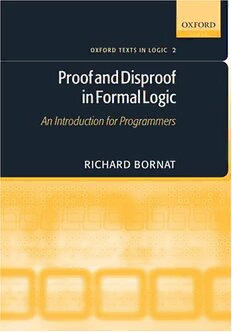
Proof and Disproof in Formal Logic: An Introduction for Programmers PDF
264 Pages·2005·3.305 MB·English
Most books are stored in the elastic cloud where traffic is expensive. For this reason, we have a limit on daily download.
Preview Proof and Disproof in Formal Logic: An Introduction for Programmers
Description:
Proof and Disproof in Formal Logic is a lively and entertaining introduction to formal logic providing an excellent insight into how a simple logic works. Formal logic allows you to check a logical claim without considering what the claim means. This highly abstracted idea is an essential and practical part of computer science. The idea of a formal system-a collection of rules and axioms, which define a universe of logical proofs-is what gives us programming languages and modern-day programming. This book concentrates on using logic as a tool: making and using formal proofs and disproofs of particular logical claims. The logic it uses-natural deduction-is very small and very simple; working with it helps you see how large mathematical universes can be built on small foundations. The book is divided into four parts:Part I "Basics" gives an introduction to formal logic with a short history of logic and explanations of some technical words.Part II "Formal Syntactic Proof" show you how to do calculations in a formal system where you are guided by shapes and never need to think about meaning. Your experiments are aided by Jape, which can operate as both inquisitor and oracle.Part III "Formal Semantic Disproof" shows you how to construct mathematical counterexamples to shoe that proof is impossible. Jape can check the counterexamples you build.Part IV " Program Specification and Proof" describes how to apply your logical understanding to a real computer science problem, the accurate description and verification of programs. Jape helps, as far as arithmetic allows.Aimed at undergraduates and graduates in computer science, logic, mathematics andphilosophy, the text includes reference to and exercises based on the computer software package Jape, an interactive teaching and research tool designed and hosted by the author that is freely available on the web.
See more
The list of books you might like
Most books are stored in the elastic cloud where traffic is expensive. For this reason, we have a limit on daily download.
